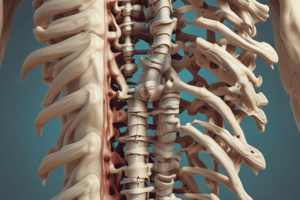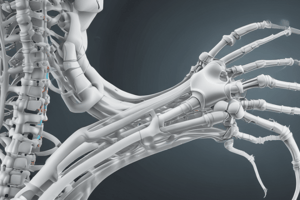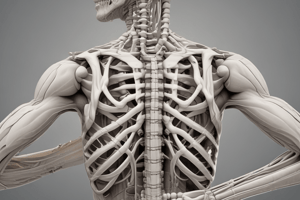Podcast
Questions and Answers
What is the primary classification distinguishing the two types of kyphosis?
What is the primary classification distinguishing the two types of kyphosis?
- Congenital and Acquired
- Postural and Structural (correct)
- Neuromuscular and Traumatic
- Structural and Non-structural
Which of the following is NOT a primary cause of kyphosis?
Which of the following is NOT a primary cause of kyphosis?
- Congenital disorders
- Postural round back
- Trauma (correct)
- Scheuermann's disease
What is the recommended treatment for managing structural kyphosis?
What is the recommended treatment for managing structural kyphosis?
- Surgical correction only
- Padded orthoses (correct)
- Medication for pain relief
- Bed rest and immobilization
Which symptom may indicate severe cases of kyphosis?
Which symptom may indicate severe cases of kyphosis?
How often should physiotherapy sessions be scheduled for managing structural kyphosis?
How often should physiotherapy sessions be scheduled for managing structural kyphosis?
What is kyphosis primarily characterized by?
What is kyphosis primarily characterized by?
In which part of the spine is kyphosis most commonly found?
In which part of the spine is kyphosis most commonly found?
What is the appearance described for kyphosis?
What is the appearance described for kyphosis?
Which term refers to an exaggerated kyphotic curve?
Which term refers to an exaggerated kyphotic curve?
What is the key difference between kyphosis and scoliosis?
What is the key difference between kyphosis and scoliosis?
Flashcards
Kyphosis definition
Kyphosis definition
Excessive curvature of the thoracic spine, creating a humpback.
Kyphosis location
Kyphosis location
Most common in the thoracic or thoracolumbar spine, but can be cervical.
Kyphosis types
Kyphosis types
Hyperkyphosis (exaggerated) or gibbus (angular).
Kyphosis effect
Kyphosis effect
Signup and view all the flashcards
Kyphosis in whom?
Kyphosis in whom?
Signup and view all the flashcards
Kyphosis Causes
Kyphosis Causes
Signup and view all the flashcards
Kyphosis Management
Kyphosis Management
Signup and view all the flashcards
Kyphosis Signs
Kyphosis Signs
Signup and view all the flashcards
Kyphosis Classification
Kyphosis Classification
Signup and view all the flashcards





